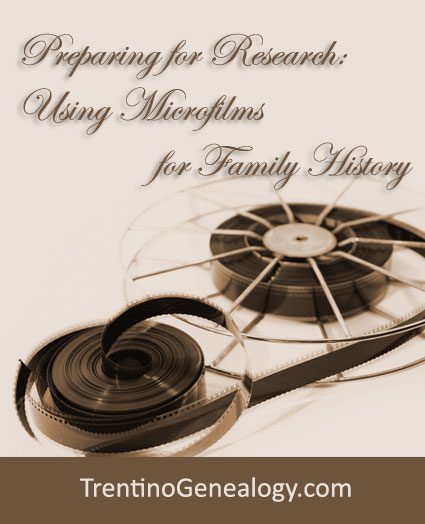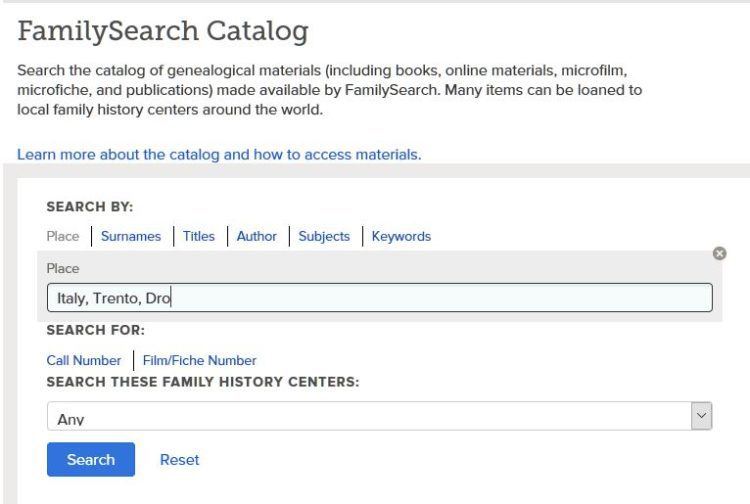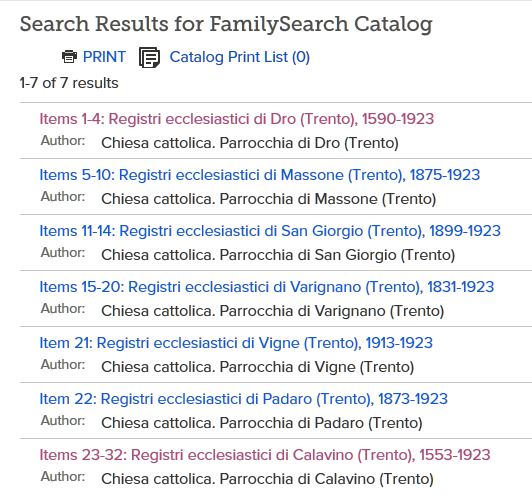 Genealogist Lynn Serafinn explains what to do before working with parish records on microfilm, and shares tips for finding your Trentini ancestors’ parish.
Genealogist Lynn Serafinn explains what to do before working with parish records on microfilm, and shares tips for finding your Trentini ancestors’ parish.
IMPORTANT NOTE (June 2019): Since I originally published this article in June 2016, the LDS Family History Centres have DISCONTINUED their microfilm ordering service, and are working on digitising all their microfilms. However, these digital images will only be viewable at one of their Family History Centres, not online. Nonetheless, the tips below might still be useful if you are lucky enough to have Family History Centre centre near you that can give you access to the old films OR the newly digitised images.
If you’re new to genealogy, you’ll notice that family historians talk a lot about parish records (if you’re unfamiliar with parish records and what they can tell you, you might find some useful information in a previous article on this site called ‘Parishes, Parish Records & Genealogy Resources for Trentino’). While parish records are fundamental to nearly every family history, they are old and fragile documents that would not survive being handled by every modern researcher who comes along. The other challenge they present is that the original, handwritten records are kept as archives in their parish of origin, often thousands of miles away from those who would like to access them.
To address both of these problems, back in the 1950s (or so I read somewhere) archivists at the archdiocese of Trento permitted historians at the Church of Jesus Christ of Latter Day Saints (LDS) to photograph these records and convert them into microfilm. The original films are kept in Salt Lake City, Utah, but copies can be rented (not purchased) by the public for a nominal fee, and viewed at their local Family History Centre (FHC). According to one source, there were more than 4,700 FHCs in 134 countries as of September 2014; it is my guess that this number has probably grown since then. You can find instructions for locating your local FHC by following the above link.
These microfilms are what the majority of English-speaking family historians with roots in Trentino use for their research. However, finding your way around the microfilms is rarely straightforward, and extracting accurate information from them requires an organised approach and regular study. I can remember numerous occasions when I was trawling through microfilms at the National Archives in Kew, London, when a first-time enthusiast came in (probably after having watched a TV show like ‘Who Do You Think You Are?’) and turned on a microfilm reader, fully expecting they would be able to trace their family back 200 years in a single sitting. Nine times out of ten, the person gives up after an hour.
Microfilms themselves are extremely unwieldy tools, and the challenges of using them are only compounded by the fact that the parish records themselves are even more unwieldy. If you’re not ready to commit yourself to many days, weeks or months (or even years, if you’re really serious) of study to master both of these challenges, you are unlikely to find much joy in using microfilms to construct your family tree.
In this article, I will be offering my advice for things you need to do before you attempt to research your Trentini roots via LDS microfilms. We’ll be looking at:
- What your ancestors may have meant when they said they were ‘from Trento’
- Finding your ancestors’ parish
- Understanding how your ancestors’ parishes may have changed over time
- Locating and ordering the film you need
- Familiarising yourself with the layout of the film
Did your ancestors actually come from Trento?
So many people of Trentino descent say to me, ‘My parents/grandparents came from Trento.’ But what they don’t always understand is that saying ‘Trento’ is kind of like saying ‘New York’. If you say you’re ‘from New York’, most people assume you mean New York City. However, ‘New York’ could also refer to New York State. So, simply saying ‘I’m from New York’ could lead people to misunderstand where you mean.
The same is true for Trento. You’ve got Trento the city, and you’ve got Trento the province (also referred to as Trentino). Furthermore, you’ve got Trentino-Alto Adige – referred to as an autonomous region – which is comprised of the two provinces of Trentino (Italian speaking) and Alto Adige (largely German-speaking). On top of this, there is the Catholic archdiocese of Trento.
SIDE NOTE: For those who may be unfamiliar, a ‘diocese’ or ‘archdiocese’ is a collection of many parishes under the ‘governance’ of an Archbishop – a high-ranking priest within the church.
In my experience, when our parents/grandparents said they came ‘from Trento’ (or ‘Tirol’/‘Tyrol’ as so many of us heard when we were growing up), they were usually referring to the province of Trento (Trentino). The fact is, the majority of those who emigrated from Trentino to the Americas in the late 19th and early 20th century did not come from the city, but from rural villages (frazioni) scattered around the province. Each of these frazioni belongs to a parish and a single parish may be comprised of a dozen or more frazioni. ALL of the parishes of Trentino (over 400 of them) come under the umbrella of the Catholic archdiocese of Trento.
Through your local FHC, you can rent individual microfilms for any of these 400+ parishes from the archdiocese of Trento. Thus, the very first thing you need to know is the name of your ancestors’ parish (or parishes).
But what can you do if you DON’T have this information?
How to find your ancestor’s parish
Even though my father was born in Trentino, he never told me name of his frazione or parish of origin. Whenever I asked him where our family came from, he would say, ‘Near Trento.’ If I pressed him further for the name of the village, he would deflect my question by answering, ‘It’s not even a village. It’s barely even a hamlet. It’s so small it’s not even worth mentioning.’ And that would be the end of the conversation. To be honest, I’m not even sure he knew.
Perhaps you were luckier that I was, and you know the name of the parish and/or frazioni of your Trentini ancestors. But if you don’t, all is not lost! Even if you have only a bit of information about your ancestors, you have a good chance of finding their parish using the Nati in Trentino website, which I mentioned in a previous article. Sometimes, simply having a surname and an approximate year of birth can reveal a definitive parish of origin. This is because many families lived entirely (or almost entirely) within a specific parish over the centuries.
For example, let’s say I was trying to track down my father’s mother, Maria Onorati, and that I had only a rough idea that she was born in the early 1890s. In this case, if I search simply for females with the surname Onorati born between 1890 and 1895, ALL of the returns are from a single parish – Santa Croce del Bleggio (the Onorati lived almost exclusively in the village of Bono in that parish for many hundreds of years). You might discover that your family name is similarly ‘attached’ to a particular parish.
Of course, many surnames will pop up in various parishes throughout the province. The more information you can put in the search form on Nati in Trentino, the more you will be able to narrow down your results (I recommend reading through my search tips in the previous article). If your search ends up giving you too many options, try to think laterally. Is there someone in your ancestor’s family – a sibling, perhaps – with a more unusual first name than your direct ancestor? For example, one of my grandmother’s sisters was named Rustica. This name is so uncommon I have only ever seen it once (i.e. in the baptismal record of my great-aunt). Searching for a ‘Rustica’ is far more likely to give me definitive results than searching for a ‘Maria’, and can therefore lead me to discovering not only the name of the parish, but also the names of the parents and other siblings.
How your ancestors’ parishes may have changed over time
Another matter that might cause some confusion for you is that parishes are not static entities, and they will probably have gone through many changes over the centuries.
- Some parishes no longer exist today because they were incorporated into another parish at some point in time.
- Conversely, new parishes may spring up having separated from another parish as populations changed.
- Sometimes, smaller villages will be ‘passed back and forth’ between two (or more!) parishes over the years. This means you’ll need to cross-check records in both parishes lest you miss something.
- Some parishes are actually ‘sub’ parishes of a larger parish. In such cases, records for a specific ancestor may appear in the registers of both
If you hit a ‘brick wall’ in your research, it could be due to this fluidity of parish boundaries. More than once I’ve accidentally stumbled upon a record I never thought I would find when I was browsing through a neighbouring parish. Another thing to remember is that, if a husband and wife in your lineage come from different parishes, it is probable their marriage was recorded in the registers of both parishes. This can be very useful if their marriage record in one of the parishes happens to be missing or unreadable.
How to order a microfilm of your ancestors’ parish records
Once you are confident you have found the parish you want to research, you are ready to order a copy of the microfilm from the LDS website. Sometimes finding the correct film can be a bit tricky, if you don’t know your way around (and, in my experience, few people at the FHC centres understand enough Italian to be able to help you).
Here’s a quick, step-by-step way to find the microfilm you need:
- In a new tab on your browser, log into your account at http://familysearch.org (if you don’t have an account, you can create one there for free).
- Once logged in, click the word ‘Catalogue’ in the top menu on your screen.
- When the search window opens, enter ‘Country, Diocese, Parish’ where it says ‘Place’. That is to say, if you are searching for a parish in the archdiocese of Trento, you should enter: Italy, Trento, Name of the Parish.
TIP: I recommend putting only the main word(s) from the name of the parish as it might be spelled slightly differently on the LDS site from how it appears on Nati in Trentino. Here’s a screenshot of what that could look like:
 click on image to see it larger
click on image to see it larger
SIDE NOTE: Even though Trentino was part of Austria prior to 1918, the records are listed under its current country (Italy).
4. When the search results for your parish pop up, CLICK the arrow next to the name to expand it. Then, click the link that says ‘Registri ecclesiastici’, etc. to open more information about it.
 click on image to see it larger
click on image to see it larger
5. Scroll down the page to see the catalogue number of the film for those parish records. Be aware that many records are spread across more than one film. For example, below you can see that the very early baptismal records for the parish of Drò are on a separate film from the other baptismal records (and marriage records), and that the death records after 1828 are on yet another film. This means, depending on the era you are researching, you may need to order more than one film to get all the records you require:
 click on image to see it larger
click on image to see it larger
6. Once you know the NUMBERS of the films you need, you can order them from the Family Search website at https://familysearch.org/films/. Just enter the number of each film and choose either a ‘short term’ or ‘extended’ loan period. While an extended loan costs slightly more, I strongly recommend choosing that option if it is available so you don’t have to worry about rushing through your research. Otherwise, the usual length of short-term loans is about three months. You can renew them, but some centres will only allow you to renew them once. In my experience, every Family History Centre has its own rules about this, so be sure to check with them first before ordering your film.
Before selecting which FHC you want to use to view the films, be sure to check their opening hours as many of the smaller centres are only open a few hours a week. You might find it better to have the films delivered to a centre slightly farther away, if their opening hours are more convenient for you.
SIDE NOTE: SOME (but by no means all) of the actual images of the Trento parish records are viewable online, but you can only view these when using the site AT a Family History Centre or if you are a member of a ‘supporting organisation’. Also, some of the records have been transcribed and can be searched online using the Family Search site. However, this research is still in its very early stages, and the transcriptions do not give nearly as much information as you will find if you consult images of the original records.
Getting familiar with your microfilm
When your film arrives at your Family History Centre, you’re probably going to be tempted to dive right into it to find specific ancestors. My recommendation is that you try to resist this urge, and spend a session or two simply orienting yourself with how the film is organised. This can save you countless hours of research in the long-term. Here’s how I work whenever I want to get acquainted with a new microfilm:
- Locate the relevant Items. Every microfilm has been broken into ‘Items’ to make navigation a bit more manageable. Not all the items on your microfilm might be records of your parish. For example, if you look at the screenshot above of microfilm number 1448235, you will see that only Items 1 through 4 (out of 32) pertain to the parish of Drò. In fact, if I go back to my catalogue search and look up the contents of this film number, I can see it contains images of records from seven different parishes:
 click on image to see it larger
click on image to see it larger
2. Get a feeling for how the records are organised. Prior to the mid-19th century, priests had no ‘standard’ system for recording events in their parish records. In fact, it was all a bit of an experiment, especially in the early days of record-keeping. While most marriage records tend to be chronological for the whole parish, the chronological organisation of earlier baptismal records can be a bit ‘loose’:
- Organisation by frazione. Many priests chose to organise birth records by frazione. In other words, they would enter all the births for a particular frazione chronologically during a specific time period, and then start the same process all over again for the next one. The ‘specific time period’ could be anything – 5, 20 or even 50 years. This means you can’t just scroll through the film to find a particular record, you’ll need to know which frazione you’re looking for, and where that frazione and time period is located on the film. Otherwise, you’ll have no choice but to scroll through pages and pages of files, just in case the record you’re looking for is hiding there.
- Organisation by first name. Even more challenging is when a priest chooses to organise his baptismal records by the child’s first name. This means you’ll see dozens of pages of Antonios and Annas followed by dozens of pages of Bartolomeos and Brigidas. Fortunately, this type of record keeping doesn’t happen too often, but when it does it can be a nightmare for research, unless you happen to be looking for one specific person whose name you already know.
3. Create a ‘map’ for yourself. Once you know which items are relevant to your research, and how the priests have organised them within each of these items, I strongly recommend making some sort of ‘map’ or guide that helps you remember where everything is, and how the information is organised. Sometimes the records have page numbers in the corners of the images (although, these numbers can be confusing, as they are numbers of the original books and not of the films themselves). In such cases, you might find it useful to make a table of where the different frazioni are located, where to find certain first names, and where different years/eras start and end in the records. Armed with this ‘map’, you will find your job much easier and less frustrating when you do your research.
Closing thoughts
I mentioned in an earlier article that, when researching parish records, I prefer to work with the digital image library at the Archives at the archdiocese of Trento. Of course, this requires making the trip to Trento (and it also helps if you speak Italian). For many people, however, going to Trento is not always possible. So, even though working with microfilms can be challenging, it is often the more practical option. Hopefully the guidelines I’ve shared in this article will help you approach those challenges with some sort of plan of attack, so you can build your Trentini family tree more easily and with greater confidence.
Coming up soon on the Trentino Genealogy blog, we’ll be looking at what to expect when working with the Archives at the Archdiocese in Trento (if you do decide to make the trip), how to interpret parish records from Trentino, an introduction to notaries and noble families in Trentino, and how to use church parchments to understand more about your ancestors’ daily lives. I do hope you’ll subscribe to this blog so you can follow along on this genealogical journey, and read all future articles on this site. Desktop viewers can subscribe using the form at the right side at the top of your screen. If you are viewing on a mobile device and cannot see the form, you can subscribe by sending a blank email to trentinogenealogy@getresponse.net.
If you have any questions or comments about this article, or if you’d like to talk to me about researching your family history, please feel free to drop me a line via the contact form on this site.
Warm wishes,
Lynn Serafinn
Subscribe to receive all upcoming articles from Trentino Genealogy! Desktop viewers can subscribe using the form at the right side at the top of your screen. If you are viewing on a mobile device and cannot see the form, you can subscribe by sending a blank email to trentinogenealogy@getresponse.net.
Lynn on Twitter: http://twitter.com/LynnSerafinn
Join our Trentino Genealogy Group on Facebook: http://facebook.com/groups/TrentinoGenealogy
View My Santa Croce del Bleggio Family Tree on Ancestry:
https://www.ancestry.com/family-tree/tree/161928829

LYNN SERAFINN is a bestselling author and genealogist specialising in the families of Trentino. She is also the author of the regularly featured column ‘Genealogy Corner’ for Filò Magazine: A Journal for Tyrolean Americans.
In addition to her work for clients, her personal research project is to transcribe all the parish records for the parish of Santa Croce del Bleggio (where her father was born) from the 1400s to the current era, as well as to connect as many living people as she can who were either born in Bleggio or whose ancestors came from there. She hopes this tree, which already contains tens of thousands of people, will serve as a visual and spiritual reminder of how we are all fundamentally connected.
View the Santa Croce del Bleggio Family Tree on Ancestry:
https://www.ancestry.com/family-tree/tree/161928829
CLICK HERE to view a searchable database of Trentini SURNAMES.
